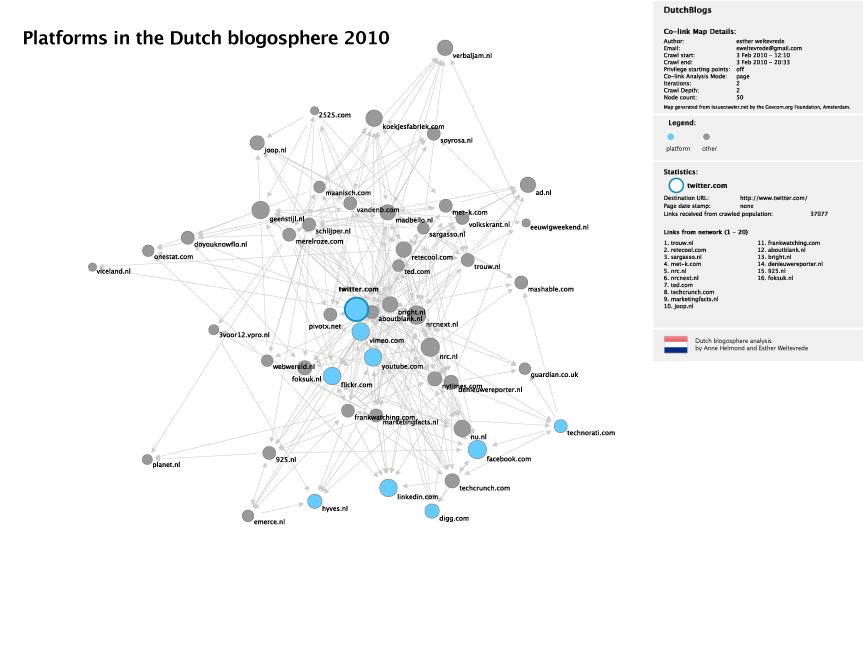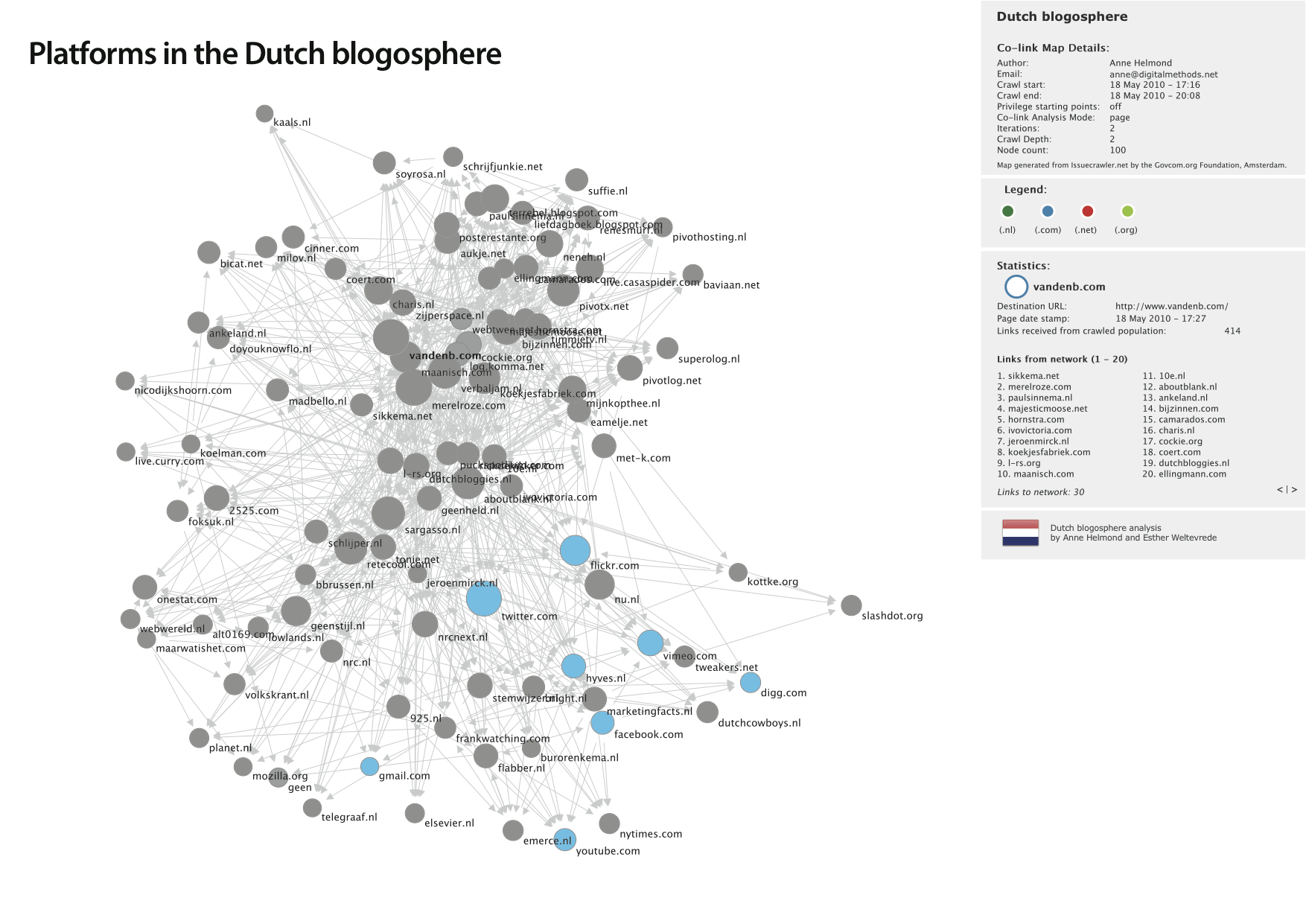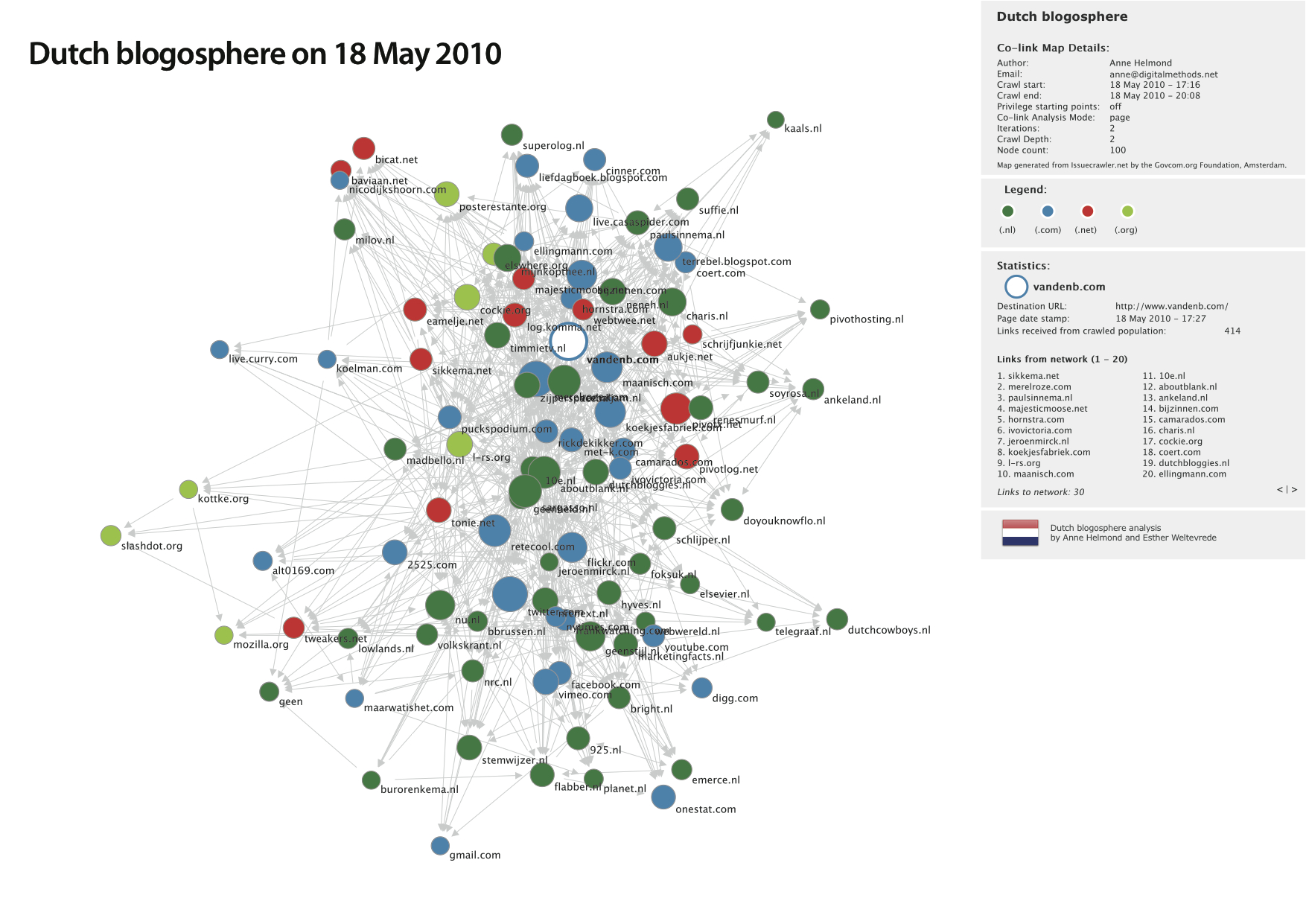You are here: Foswiki>Dmi Web>DutchBlogosphere2003 (21 Jun 2013, AnneHelmond)Edit Attach
The Dutch Blogosphere
Weltevrede, Esther, and Anne Helmond. 2012. “Where Do Bloggers Blog? Platform Transitions Within the Historical Dutch Blogosphere.” First Monday 17 (2-6). http://firstmonday.org/htbin/cgiwrap/bin/ojs/index.php/fm/article/viewArticle/3775. The text below is a draft, please refer to paper above or the new project page: Dutch BlogosphereDraft
Introduction
Lifeloggers and linkloggers In 2003 Frank Schaap wrote an article on the Dutch blogosphere in which he noted the vibrant state of the Dutch blogosphere with the monthly e-zine About:Blank, its own Dutch Bloggies awards and two Dutch blog weblog systems (Pivot and ?). However, until then the Dutch blogosphere had been rather unknown to him due to the dominance of the English language on the internet. In his article Schaap makes several claims about the Dutch Blogosphere:- The Dutch blogosphere demarcates itself through linking policies in the blogroll: "Conversely, Dutch weblogs almost exclusively link to other Dutch weblogs in their blogroll, which only occasionally includes English language weblogs. In their entries, Dutch weblogs do link to English language web sites and copy or translate their news but the links of affiliation remain overwhelmingly with other Dutch weblogs. The Internet may be transnational but many communities remain bound by barriers of language."
- The Dutch blogosphere looks at the English-language blogosphere but incorporates changes in a specific Dutch context, "showing the process of "glocalization" at work (Robertson 1995 in Schaap 2003)"
- The Dutch A-list is small: "but there is a small set of some 50 to 75 high profile weblogs that get referenced and linked to a lot. This set of high profile weblogs consists mostly of weblogs that were among the first and second wave of weblogs, combined with some newer weblogs that have quickly gained popularity because of their particular format and content. However, few of the maybe two dozen "old school" weblogs, that were started in 2000 or even earlier, now remain, but a lot of the "second wave" weblogs, that were started in 2001, are still actively maintained. "
- Schaap distinguishes Dutch lifeloggers from linkloggers:
- Lifeloggers: 1) "Links to other weblogs, mentioning other webloggers, and commenting on what another weblogger wrote are means by which webloggers position themselves in the blogosphere. But lifelogs are about their authors." 2) "The lifelog may be located on the Web, but just as with many personal home pages it provides many links and details about the author's everday, offline life. Adding an "About Me" page, pictures, or maybe a webcam, reinforces those links." 3) "In fact, just like on the home pages earlier discussed, lifeloggers primarily present themselves through well-known categories like work, family, friends, musical preferences, place of residence, pets, and political opinions to name but a few." 4) "Because The Netherlands is such a small country, no one lives more than a 2.5 hour trip away, unless they happen to live abroad. I have as of yet only briefly explored the "back channel" and offline communication and interaction, but the latest meeting brought together some 50 webloggers."
- Linkloggers: 1) "The situation is different on linklogs. Most of the high profile linklogs are not produced by one author but by a small group. The linklog authors of the high profile linklogs give out few or no personal details about themselves and use a pseudonym or, supposedly, their first name, but never their last name." 2) "Dutch linklogs always try to cause a stir, either by linking to information that already is the focus of some sort of row, or that will become the focus of a row because they are linking to it. This includes sensitive information about people, shocking and doctored pictures, pictures and links of hot babes but also hardcore porn, cool flash movies and games, and, quite popular as well, opendir links."3)"Although the authors provide a particular direction and give the linklog its unique slant, their personality is secondary to the linklog's genre of "programming," which is the basis for its hits and thus for its success."
- Especially with link logs, there is a difference between popularity by hits and popularity by links.
Research Question
How have linking practices in the Dutch blogosphere evolved since 2003? When did the Dutch blogosphere move from linklogs to lifelogs to platformlogs? Are there other historical periods that can be distinguished analyzing the results? Can we identify different platforms belonging to different periods?Method
Current blogosphere:
- Create StartingPointsNLBlogosphere. The list is created from expert sources & two important Dutch log lists, the Loglijst and the Nedstat lijst. Sources:
- Loglijst 2003 - http://web.archive.org/web/*/http://weblog.lijst.nl/
- Meeuwsen, Frank. Bloghelden. Amsterdam: Bruna, 2010.
- Nedstat top 1000 weblogs' statistics - http://www.nedstatbasic.net/s?tab=4&link=3&id=837798&country=NL&category=3016
- Roze, Merel, and Chrétien Breukers. Schrijfwijzer voor het web. Amsterdam: 2009.
- Schaap, Frank, ‘Links, Lives, Logs: Presentation in the Dutch Blogosphere’, Into the Blogosphere: Rhetoric, Community, and Culture of Weblogs
- Create hyperlink network using the Issuecrawler
- Color code social media platforms
Archived blogosphere:
- Create StartingPointsNLBlogosphere
- Archive collection of the Dutch blogosphere using the Internet Archive.
- The archive data set is periodized according to the following method: Periodization of the Internet Archive will happen through a k-means clustering algorithm. The algorithm allows to define the number of clusters (e.g. 4 periods corresponds to 4 clusters). The algorithm groups all time stamped urls into x clusters which are maximally coherent internally and maximally exclusive externally. Similar to results from mapping the A-list blogosphere.
- A customized linkripper tailored to the Archive of the Archive is used to extract all outbound links from the archived archive by an archive-link-ripper. The tool only extracts links from the first page as pages on the second or third level in the archive might not be from the same archival date.
- (Point of consideration: do we take all links into calculation or only use lists like blogrolls? Both are interesting but note that these produce very different maps. The all-links-option is random because we only take the posts that are on the front page of the blog; it is good because it not only shows a blogosphere of 'friends' but rather a blogosphere that can be characterized by its links to news or tech for example. Additionally, this analysis method more closely resembles the issue crawler analysis method. The blogroll only option is preferred because it is random. )
- From the archived collection, fetch outlinks (1 iteration, 1 depth) and create a hyperlink network with Gephi. Repeat this step for each year.
- Iteratively check the outcomes of the network whether they are blogs or not and subsequently use the blogs as starting points for next years' archive crawl.
- As a check, use Frank Schaap's important historical blogs to see whether our method is correct, e.g. whether we found important historical blogs in the right year.
- Use the expert lists to detect clusters (e.g. literary blogs, linkdumps).
- Analysis: How do the hyperlink structures change over time? What type of clusters emerge? What can be read from the hyperlink structure? Are there distinct linkloggers and lifeloggers clusters? When do platforms and social media emerge in the network?
Archived blogosphere MIT7
text hereAnalysis of the data & further research
Mapping the changing practice of blogging in the Netherlands
When did the Dutch blogosphere move from link blogs to weblogs to widgetized blog? Are there other historical periods that can be distinguished analysing the results? From the archived collection, fetch outlinks (1 iteration, 1 depth) and create a hyperlink network. Repeat this step for each year. How do the hyperlink structures change over time? What type of clusters emerge? When do platforms and social media emerge in the network?Diagnosing the current condition of the 2003 Dutch Blogosphere
- Liveliness metrics: Are the 2003 blogs still online? --> fetch reponse code with http://marijn.digitalmethods.net/scrp/responder.php
- Freshness metrics: How fresh is the content on the blogs that are still online? --> fetch date stamp from RSS
- Hijacked metrics: Are the blogs still online parked, for sale or hacked? --> (need a rubust method for this)
- Popularity metrics: What is the current popularity of the blogs that are still online? --> fetch Pagerank, fetch traffic stats from alexa.com and trends.google.com
- Dated software metrics: How up to date is the software used in the blogs? --> (create method for this. List of historical software (e.g. platforms, browser, java etc)
- Creation data metrics: When where blogs first registered? --> fetch whois data
- Brokenness metrics: Do the links still work? use link validator
Web Words
How did interface language change over time? Use the special collection downloaded from archive.org and create method to map this.Linklogs versus Lifelogs
Lifeloggers have online meetings. Do they correlate with online Dutch blogopsheres? http://wiki.bloghelden.nl/page/Weblogmeetings and http://www.rolandow.com/vp04/index.phpFindings
In a sample from the Dutch blogosphere we looked at the outlinks of the actors in the startlist and we found that Twitter, Flickr, Facebook, Hyves and other social media platforms appear as important actors within the network. In this sample of May 2010 Twitter is the dominant platform in the Dutch blogosphere receiving 34484 links from the crawled population. In 2010 social media platforms receive the most links from the crawled population indicating their prominence on the web and in the blogosphere. Claim: We have moved from a bloggers A-list to a platform A-list consisting of a top three of: Twitter, Flickr, YouTube. The linking structure of the Dutch blogosphere anno 2010 is characterized by social media platforms. In 2010 linking practices show the dominance of software platforms in the Dutch blogosphere. Twitter, Vimeo, YouTube and Flickr are central nodes in the network along with Technorati, Facebook, Digg, LinkedIn and Hyves.
In 2010 linking practices show the dominance of software platforms in the Dutch blogosphere. Twitter, Vimeo, YouTube and Flickr are central nodes in the network along with Technorati, Facebook, Digg, LinkedIn and Hyves.
Literature
Bruns, Axel. "Methodologies for mapping the political blogosphere: An exploration using the Issuecrawler research tool." Firstmonday. http://firstmonday.org/htbin/cgiwrap/bin/ojs/index.php/fm/rt/printerFriendly/1834/1718- top335NLweblogs.ods: top335NLweblogs.ods
- bloghelden_platforms.pdf.jpg:

- bloghelden_dutchblogosphere.pdf.jpg:

- bloghelden_dutchblogosphere.pdf: bloghelden_dutchblogosphere.pdf
- bloghelden_platforms.pdf: bloghelden_platforms.pdf
Erik's notes
- Extracted linkurl from db dump, cleaned URL list to exclude non-existent and empty URLs. Retained 695 URLs.
- Looking for middle of year, as described here: http://web.archive.org/collections/web/advanced.html
- but: http://web.archive.org/web/*/http://www.bonga.nu/speciaal/eigenhuisenlog/ vs http://web.archive.org/web/2001/http://www.bonga.nu/speciaal/eigenhuisenlog/ (gives oct instead of jun or aug)
| I | Attachment | Action | Size | Date | Who | Comment |
|---|---|---|---|---|---|---|
| |
bloghelden_dutchblogosphere.pdf | manage | 824 K | 28 May 2010 - 15:55 | AnneHelmond | |
| |
bloghelden_dutchblogosphere.pdf.jpg | manage | 814 K | 28 May 2010 - 15:55 | AnneHelmond | |
| |
bloghelden_platforms.pdf | manage | 814 K | 28 May 2010 - 15:56 | AnneHelmond | |
| |
bloghelden_platforms.pdf.jpg | manage | 767 K | 28 May 2010 - 15:56 | AnneHelmond | |
| |
cluster_map_platforms.pdf | manage | 417 K | 04 Feb 2010 - 13:54 | AnneHelmond | Cluster platform |
| |
cluster_map_platforms.png | manage | 54 K | 04 Feb 2010 - 13:50 | AnneHelmond | Cluster platform |
| |
top335NLweblogs.ods | manage | 44 K | 28 Jan 2010 - 14:14 | AnneHelmond |
Edit | Attach | Print version | History: r20 < r19 < r18 < r17 | Backlinks | View wiki text | Edit wiki text | More topic actions
Topic revision: r20 - 21 Jun 2013, AnneHelmond
 Copyright © by the contributing authors. All material on this collaboration platform is the property of the contributing authors.
Copyright © by the contributing authors. All material on this collaboration platform is the property of the contributing authors. Ideas, requests, problems regarding Foswiki? Send feedback


